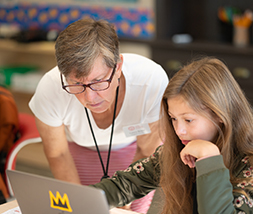Curriculum Guide
Mathematics
Throughout the Mathematics Curriculum, students are encouraged to both master specific processes and develop a thorough understanding of the concepts behind them. As they develop in their mathematical thinking, students move away from rote arithmetic to applications and problem-solving. Learning how to apply skills, both in and out of the context in which they were taught, provides students with a deeper understanding of how and why they will use mathematics as a valuable tool in their lives. Students work individually and collaboratively in group activities to solve a variety of problems.
All students in Class I and Class II have math class in mixed groups. Starting in Class III, students are recommended for a standard pace or faster pace prealgebra course. Algebra 1 is also offered to qualifying Class III students. All students have the opportunity to participate in the Elementary School Math Olympiad (Classes I and II) or the Middle School Math Olympiad (Classes III and IV), as well as the AMC 8 math competition.
Class I
Students study arithmetic using whole numbers, fractions, and decimals to understand concepts and strengthen skills. Manipulatives and models are used to help illustrate some concepts. Other topics include measurement, geometry, data handling, and estimation. Mental and written computation is emphasized, but calculators or computers are used for appropriate activities. Students work individually as well as in groups when appropriate.
Class II
The mathematics curriculum focuses on operations of rational numbers, including fractions, decimals, and negative numbers, as well as the number line. The order of operations and application problems will be studied. This allows students to begin to solve linear equations, develop proportional reasoning skills, investigate percents, and explore two- and three-dimensional geometry topics. Throughout the year, students engage in various problem-solving exercises to apply their math skills. Scientific calculators are introduced.
Class III
Pre-algebra
The course includes writing algebraic expressions and solving equations and inequalities, exponent properties, angles in polygons, ratio and proportion, probability, and an introduction to linear functions. Application of these topics is built-in throughout the course.
Algebra 1
Students in Algebra 1 study linear and nonlinear functions and equations. The course begins with solving linear equations and absolute value equations, solving linear and compound inequalities, graphing linear functions, and writing linear functions when provided a variety of information. It then progresses to manipulating properties of exponents, exploring exponential functions, simplifying and factoring polynomials, solving quadratic equations, and graphing and analyzing quadratic functions. During the year students develop and refine their problem-solving and critical thinking skills, and a variety of word problems and applications are presented. Students are introduced to online graphing software to explore linear and nonlinear relationships. This course is open to students by permission of the department only.
Class IV
Algebra 1
Students in Algebra 1 study linear and nonlinear functions and equations. The course begins with solving linear equations and absolute value equations, solving linear and compound inequalities, graphing linear functions, and writing linear functions when provided with a variety of information. It then progresses to manipulating properties of exponents, exploring exponential functions, simplifying and factoring polynomials, solving quadratic equations, and graphing and analyzing quadratic functions. During the year students develop and refine their problem-solving and critical thinking skills, and a variety of word problems and applications are introduced. Students are introduced to online graphing software to explore linear and nonlinear relationships.
Algebra 2
All students will study the core topics of Algebra 2: quadratic equations and functions, and polynomial equations and functions. Complex numbers, systems of equations, inverse functions, transformations, and rational expressions will also be studied. The algebraic and graphical aspects of each topic will be emphasized. The applications of the TI-84 graphing calculator will be introduced. This course is open to students who have completed a full year of Algebra 1 at Winsor or by department permission.





